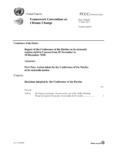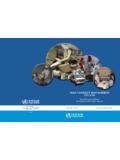Transcription of Resource Mobilization - World Bank
1 Resource MobilizationThis brief is one in a series of tips for civil society organizations written from a funder s is intended to stimulate inquiry, rather than to provide rigid instructions. T i ps f o r St r e ngt he ni ng Or ga ni z a t i o na l Ca pa c i t yResource MobilizationTips for mobilizing resources closer to home to strengthen organizational capacity and deliver benefits to the tips include diverse methods for mobilizing resources starting with preparing for fundraising, a s s e s s i n g a n d u s i n g community strengths, and soliciting external funding DevelopmentTips for developing and implementing a project and key questions to ask in the process. BudgetingTips for preparing a budget with an emphasis on its purpose, steps, and components. Financial Systems Tips for establishing an accountable and transparent financial system to build financial & EvaluationTi p s f o r r e v i e w i n g a n d assessing progress towards objectives, identifying problems and strategies, and making adjustments to Proposal WritingTips for developing and writing a proposal, including critical elements to facilitate project to FundersTips for maintaining and strengthening your relationship with funders following a grant award.
2 PURPOSE OF Resource MOBILIZATIONHow can an organization raise the income needed to carry out its mission? Where are the required resources? How do you sustain your organization and work? These are the key questions confronting organizations when they consider how to maintain their work and strengthen organizational a plan or strategy for Resource Mobilization can lead to creative efforts in using your own local assets to gain support for your organization. Multiple sources of funding can increase your independence and flexibility to implement programs and reduce reliance on external (or foreign) funding. With increased competition for scarce grant resources, thinking of, and creating options for new, diverse, and multiple funding streams will help your organization manage its programs. This brief starts with aspects to consider prior to mobilizing resources.
3 The tips on Resource Mobilization first discuss what your organization can do locally before soliciting external sources for FOR FUNDRAISINGB efore you start fundraising, you should lay the foundation to have a compelling reason for donors to give. A plan that weighs your options can help save time and effort and have a better chance of success. Some of the key elements that will strengthen your case include:Clear sense and commitment to your vision and mission -- who you are, where you are going, and how your mission relates to the communities servedPromising program that will yield results Evidence of past accomplishmentsEffective management and leadership by your board members and staff who will ensure the accountability and transparency of the organizationFinancial systems that will safeguard the resources raised, including adequate financial controls that demonstrate good management and builds trustSolid reputation, credibility, and positive imageMutual respect and knowledge sharing between the organization and the community it benefits, as well as other stakeholdersThe ability to attract, create, and sustain new resources, especially based in the local communityRESEARCHING THE CURRENT SITUATIONF undraising requires knowledge of the country s current situation.
4 Including legal and tax structures, as well as what kind of fundraising activity could succeed in your unique environment, for example: The legal situation in your country may allow or restrict certain types of activities for your type of organization. Be familiar with any special permission that is required for your fundraising activities Tax consequences may affect how your organization reports the income and should be a consideration for selecting the appropriate activity Tax relief for individual or corporate donations may be an incentive for giving Successful fundraising efforts of other civil society organizations (CSOs) may be replicated. On the other hand, creating innovative and fresh ideas may also inspire people to contribute Building on local cultural and religious practices and traditions may help to attract a certain audienceWORLD BANK SMALL GRANTS PROGRAM 1 MAPPING YOUR COMMUNITY S ASSETSEach community has a unique set of assets upon which to build its future.
5 The first step in a fundraising strategy is to identify and inventory the range of financial and non-financial resources of the individuals, community (including NGOs, groups, and associations), and local institutions (including local government agencies). Non-financial resources include skills, talents (such as handicrafts), and capacities. Mapping can help your organization consider alternate and efficient resources for your proposed project. You may rediscover innovative solutions by mapping traditional technologies and practices, in areas such as pest control or conflict resolution. By being aware of your community members skills, you may be able to use a local resident to deliver services or training, rather than hiring an external consultant. Focusing on the community s assets could help to localize your fundraising and engage the local citizens to invest in their own future and create a sense of hope and control.
6 Knowing one another s assets could also help to build relationships among local residents, associations, and institutions. VOLUNTEERS AS RESOURCESV olunteers can provide great resources and benefits to your organization. Volunteering is generally done by choice, without monetary reward (apart from expenses), and benefits the community. To recruit and keep your volunteers, you need to recognize the motivations and expectations of a volunteer. People give their time because they get something out of the service they provide. For example, a young person may gain skills or experience to apply for future opportunities. Volunteers can be retirees, technical experts, young people, or student interns. They can serve for a long term, such as on your board or short term, such as providing labor to build a health facility.
7 They may be a local resident or someone from another country. Regardless of who they are and what skills they bring, you may want to think systematically about managing volunteers to get the most of this valuable human Resource . Some steps are: Identify tasks that need to get done, outline a job description, duration of the volunteer service, and profile or skills required. Depending on your needs, recruit volunteers from places such as local schools or universities or inquire about foreign volunteer programs for placement of volunteers in your CSO. Corporations, local government offices, community associations, and other agencies may have skilled human resources to fill gaps in your organization. Mapping your community s assets may help you to identify local residents with specific skills and capacities. Ensure quality of the work by interviewing, selecting, and hiring the person with the appropriate qualifications.
8 Managing volunteers can be as time consuming as managing staff. Retain volunteers by supervising them and providing support and mentorship as required. Volunteers usually desire opportunities that are meaningful and can fulfill their own needs (such as skills development, social environment, networks, learning). Recognize and acknowledge the volunteer in staff meetings and in public (in a newsletter or public event). Appreciation goes a long way. Keep track of volunteer hours and record this in your reports to funders and other stakeholders. This is a demonstration of in-kind RESPONSIBILITIESA strong governance structure, such as a board of directors, is important to have in place to lead the organization in Resource Mobilization efforts. Funders may ask about the governance structure and composition (for example, gender breakdown or community member involvement) and board members names and affiliations.
9 The Board of Directors typically consists of volunteers with specific skills, knowledge, and experience. In many cases, they will be the body that is responsible and accountable to funders for the governance and finances of the of Leadership ResponsibilitiesConsider including Resource Mobilization as one of the responsibilities for board members. Some examples of what a board member could do to help mobilize resources are: Cultivate potential supporters Speak on behalf of the organization and issues Strategize with staff on fundraising Recruit volunteers Donate to the e s o u r c e Mo b i l i z a t i o nWORLD BANK SMALL GRANTS PROGRAM 2 INCOME GENERATION ACTIVITIESMEMBERSHIP DUESYour organization may have members who form, own and operate the organization. The organization can generate cash from membership dues or subscriptions. The amount should be spelled out in the original charter or bylaws and may be done on a sliding scale.
10 Members are also a good source of volunteers and spokespeople for your cause. In return, the organization will be accountable to the membership base and provide benefits to them. Example of a Membership DriveTo enroll new members, consider conducting a house-to-house membership drive where volunteers recruit new people to join your organization. Give new members an incentive to join -- a social gathering to orient new members, a membership card to show their affiliation, or a reduced price for the first month. SPECIAL EVENTSS pecial events, also known as benefits, are a popular fundraising activity. The organization sells tickets to a social event, concert, dance, or sports tournament and adds a margin of profit. You can also sell crafts, T-shirts with your logo, or food at the event to make more money. You can have a work party where you bring the community together for a day to help renovate houses or a community events can be a fun way to publicize your cause, raise awareness of a specific issue, introduce a new program, create a positive image of your organization, outreach to your community about your services, mobilize your constituency, and celebrate your accomplishments.
















